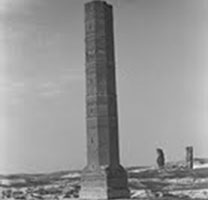Emar was situated on the middle Euphrates in northwest Syria, about 100 km east of Aleppo. Due to its geographical situation connecting Mesopotamia with the Mediterranean coast. The town had a strategic function. Already the earliest mentioning’s in writing, namely in the palace archives of Ebla, ca. 2500 BC, and especially in the Mari texts from the 18th century BC, point to the town’s importance as traffic junction .
Contrary to its importance as a commercial center, Emar was never the center of a supra-regional power, but was rather awkwardly positioned between rivaling states. The history of Emar can be followed down to the middle of the third millennium BC, or, in archeological terms, down to the Early Bronze Age, when the town came under the influence of the rulers of Ebla and was mentioned in their archives at several instances. For the 13th and the early 12th centuries BC (the Late Bronze Age), there is written documentation from Emar itself and also references in contemporaneous texts from Boazköy/Hattua, Ras Shamra/Ugarit and from Assyria. At that time, the town was part of the Hittite Empire, situated close to the frontier of the rivaling state of Assyria. Emar was subject to the king of Karkami, who represented the Hittite ruler in Syria, a member of the Hittite royal family and the connecting link between Hattua the Hittite capital in central Anatolia, and the Syrian “vassal states.”
the Emar texts have mainly been found in private houses. They are, above all, judicial records – concerning, for example, dealings in real estate, marriages, last wills, adoptions – illustrating the private life of the population and, at the same time, showing the consequences of the Hittite conquest for the training of scribes and for society, in general. In the house of a priest, the so-called Temple du Devin (M1), a library was found containing, besides literary and lexical texts in the Mesopotamian tradition, ritual texts for local cults. Particularly noteworthy is the ritual for the installation of the priestess of the weather god. At Emar, archeologists discovered a temple area comprising the sanctuaries of the weathergod Ba’al and – possibly – of his consort Ashtarte as well as several dwelling-houses dating to the Late Bronze Age (13th and beginning of 12th century BC).
N.H.Khider
Source: Excavation Emar

